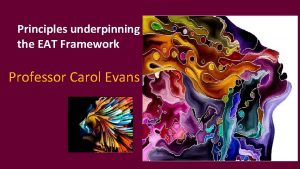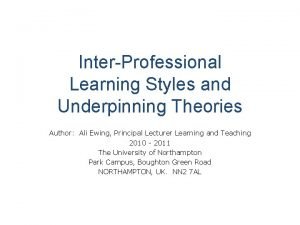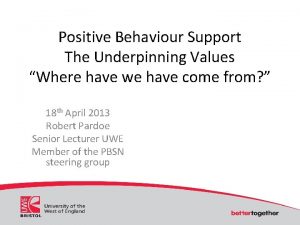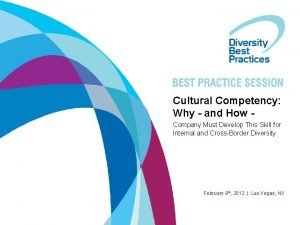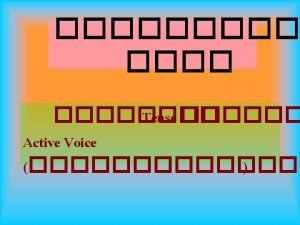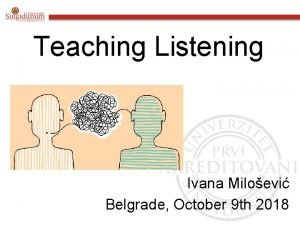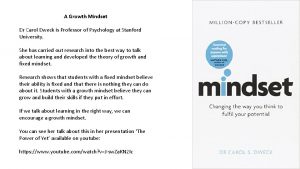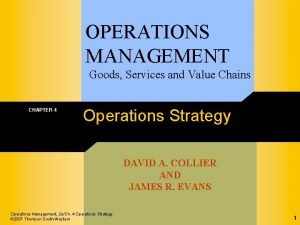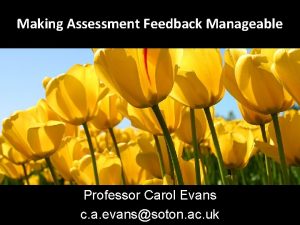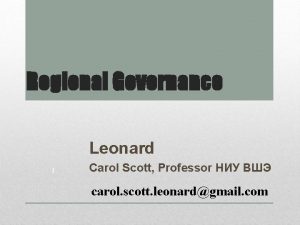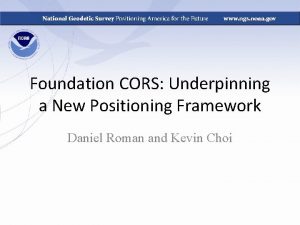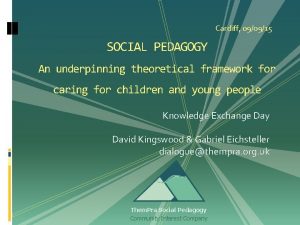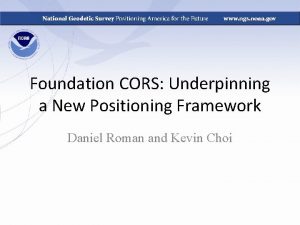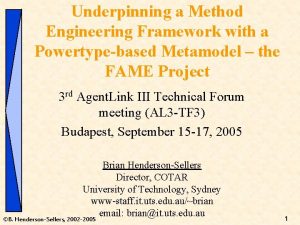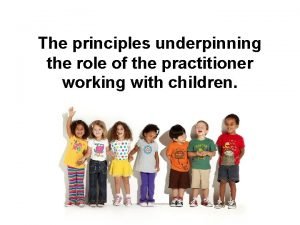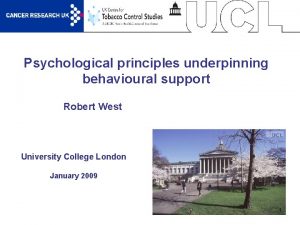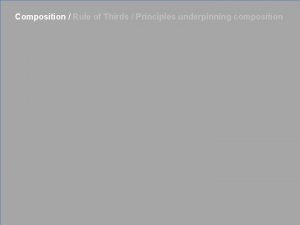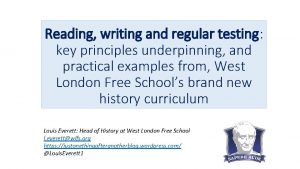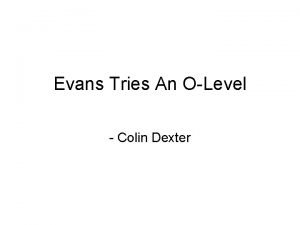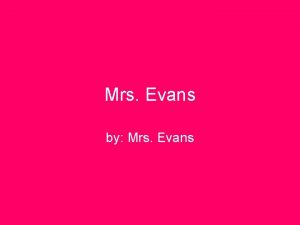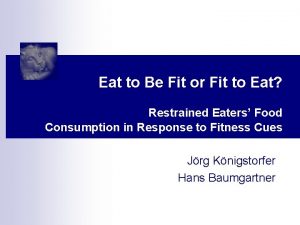Principles underpinning the EAT Framework Professor Carol Evans












































- Slides: 44

Principles underpinning the EAT Framework Professor Carol Evans


Fundamentals Equity Agency Transparency https: //www. frontiersin. org/articles/10. 3389/feduc. 2018. 00069/full

How students come to co-own their programmes with lecturers and see themselves as active contributors to the assessment feedback process rather than seeing assessment as something that is done to them (EAT, 2016) Issue is not to perpetuate the need for external regulation

ALL ABOUT DESIGN Greater emphasis should be placed on assessment designs that promote student engagement with all dimensions of the assessment process as part of ‘knowing to’ (Sadler, 2013)


7

What we do in assessment and how we do it impacts achievement – it is the micro details of the approach and how attuned it is to context What are the variables that impact our practice? Who are our tribes? Are they all benefitting equally?

Key Themes in Effective Designs Relevance • • Agency Partnership • Use of guided discovery • Bringing the outside in experiences Real life examples (Bass, 2012) • Universal Design Connecting with Partnership communities within and • Ensuring accessibility of • Engaging students in assessment design materials / processes / beyond HE • Supporting students’ procedures Forward thinking development & • Emphasising student Design of Assessment: navigation of learning self-management The long game environments • Transparent • Co-authorship • Shared ownership 9

To what extent do we have a shared understanding of assessment and how it should be operationalised?

Meaningful Assessments personalising and creating their own criteria (Taras, 2015) being trained in using, triangulating and making sense of feedback (Evans, 2013; Forsythe & Johnson, 2017; Winstone et al. , 2017). reviewing work of varying quality (Sadler, 2010, 2013). acting as reviewers of others (Nicol, Thomson, & Breslin, 2014). self-assessing and feeding back to others (Boud et al. 2013; Carless, 2012; Deeley, 2014). working with assessment to do the noticing, the thinking about repair and modification, and the generation of ways to improve (Sadler, 2013, p. 57) as 'knowing to'. co-constructing habitus in generating dispositions to act and perceive in the discipline (Gray, 2013; Yu & Hu, 2017). working as co-producers with the wider community in boundary-crossing, integrative, and socially networked experiences, that bridge HE experiences with life outside of it (Bass, 2012). designing assessment with lecturers (Riley, 2017; Riley, Mc. Cabe, & Pirie, 2017) teaching and researching with peers and lecturers (Scott, Moxham, & Rutherford, 2013).

Strategy development is a leveller – “Students’ strategies for learning and exam preparation, for effort regulation, and goal -setting demonstrate stronger relationships with achievement than their personalities or personal backgrounds” (Schneider and Preckel, 2017, p. 595)

Best use of time Metacognitive, Cognitive and Affective Regulation Reducing overload especially during transitions Clarifying requirements Developing strategy to ‘choose deliberately when and where to invest time and mental resource’ (Schneider & Preckel, 2017) BELIEFS AND VALUES MATTER Role of emotions: Evans, C. (2015). Exploring students’ emotions and emotional regulation of feedback in the context of learning to teach. In V. Donche, S. De Maeyer, D. Gijbels, H. van den Bergh (Eds. ) (2015). Methodological challenges in research on student learning (pp. 107 -160). Garant: Antwerpen.

Supporting students in ‘knowing how to improve’ is about enabling them, through course design, to regularly test their understandings, to be able to seek and use resources effectively, manage their emotions, and not be reliant on external feedback ----- taking us back to self-regulation How are we developing an evidence-base to inform what we do?

What are your drivers? ‘To maximise the potential of pedagogical innovations, assessment is the lynchpin as it must keep pace with what disciplinary knowledge is seen as valuable and relevant within HE and wider contexts and needs to accurately measure meaningful learning’ Evans, with Muijs and Tomlinson (2015) 15

What is valued? students and lecturers need agreement on what meaningful and quality learning experiences are. . . The freedom to learn, to have opportunities to connect in being able to take disciplinary understandings forward and being able to apply and offer them to workplace and other contexts as co-partners and producers Evans et al. , 2015 16

Inclusive • • we need to constantly explore whether any learner is being excluded from assessment – universal design perspective – designing learning so everyone has access NOT designing with a specific learner in mind. Need to think about: Nature of assessment – do all have equal access to content; is there sufficient variation in tasks across a programme; does assessment allow a learner to demonstrate what they can do? Is feedback given in time to allow a learner to use it Where there is free choice how are learners supported to make sensible choices? Does the timing of assessment unfairly impact certain learners Is information provided in good time to allow students to navigate it as they choose. Is information clear, accessible and explicit. 17

Critical Pedagogies “Critical pedagogies supply a significant amount of the intellectual capital of the discipline of pedagogy” (Canning, 2007, p. 400) enabling a reflexive research and practice-informed approach to critiquing learning and teaching from different perspectives. Consideration of who is advantaged and disadvantaged by pedagogical initiatives at a number of levels is of profound importance. ” (See Waring and Evans 2015) 18

Critical Pedagogies “Critical pedagogies supply a significant amount of the intellectual capital of the discipline of pedagogy” (Canning, 2007, p. 400) enabling a reflexive research and practice-informed approach to critiquing learning and teaching from different perspectives. Consideration of who is advantaged and disadvantaged by pedagogical initiatives at a number of levels is of profound importance. ” (See Waring and Evans 2015) 19

Critical Pedagogies “Critical pedagogies supply a significant amount of the intellectual capital of the discipline of pedagogy” (Canning, 2007, p. 400) enabling a reflexive research and practice-informed approach to critiquing learning and teaching from different perspectives. Consideration of who is advantaged and disadvantaged by pedagogical initiatives at a number of levels is of profound importance. ” (See Waring and Evans 2015) 20

Shared beliefs and values Students come into a programme with beliefs and values about the discipline and how it should be taught. They have established schema about what is right. Harnessing student buy-in is crucial. How are you: • Working with students to explain why things are designed in the way they are • Sharing with students the rationale underpinning what you are doing • Explaining how the assessment opportunities will support their learning • Demonstrating how what you are doing is relevant to the discipline and work beyond the programme • Designing the programme with students to ensure student buy-in • Clarifying with students their role in the process……………… 21

Beliefs, Values, Priorities …they are rational agents, with tremendous demands on their time and attention, and must make choices about where to focus their energies and attention most efficiently… their brains are engaging in a continuous process of triaging for the allocation of finite neural resources… the students who derive joy and satisfaction from the more immediate goals of understanding…may have a chance of using the brain’s capacity to provide reward signals on an ongoing basis, thus effectively facilitating their learning process. Friedlander et al. (2011, 416 -417). 22

Beliefs, Values, Priorities …they are rational agents, with tremendous demands on their time and attention, and must make choices about where to focus their energies and attention most efficiently… their brains are engaging in a continuous process of triaging for the allocation of finite neural resources… the students who derive joy and satisfaction from the more immediate goals of understanding…may have a chance of using the brain’s capacity to provide reward signals on an ongoing basis, thus effectively facilitating their learning process. Friedlander et al. (2011, 416 -417). 23

Student Engagement How students come to co-own their programmes with lecturers and see themselves as active contributors to the assessment feedback process rather than seeing assessment as something that is done to them 24

Holistic • How does the design of assessment consider the whole package that students experience – programme level journey they go on? • • How are we working with colleagues across modules; disciplines; professional services to support the development of the module / programme • How does the approach link to beyond the university? 25

Post Course Design “paying attention to such elements as prior learning and prior conceptions, experiential knowledge, program-wide learning goals, and the long view of expert practice. There also many ways to create assignments (and reflections to go with assignments) that gesture beyond the course itself—to life experience, to other courses, or to larger communities of practice. . . ” (Bass, 2012, pp. 26, 27) Bass, R. (2012). EDUCAUSE Review, 47(2), 23 -33. 26

Sensitive to context • consideration of individual and contextual variables • What are the requirements of the discipline are they clear to the student? • What do the students bring within them into the programme – how can we make best use of the knowledge, skills, and attributes they have already? • Are we clear about the elephants in the room and how are we addressing these in our teaching? • How are we building a community that they feel part of? 27

Facilitators and Barriers in your use of assessment and feedback assessmentcontextual space postives Negativess Positives Negatives postives Things you bring to the teaching environment – personal characteristics – socio-emotional space

Agentic • Agentic for staff and students critical in promoting autonomy • How are we using the student entitlement agenda to build student responsibility/agency/ autonomy? • What can and what should students be leading on? • What the black and white and grey areas? These need to be clarified – what is open to negotiation and what is not? • How is assessment designed so students can pitch their ideas and take responsibility for their choices? 29

Self-regulation Cognitive how you process info Metacognitive understanding how you learn Affective how you manage your emotions

Self-regulatory • How is your design of assessment enabling students to take responsibility for their own learning? • How are you supporting students to self-evaluate their own performances? • How are you supporting students to manage the emotional dimension of learning? • How are you supporting students to know what to do when they don’t know? • How are you supporting students to build their own networks of support? 31

Engagement in Meaningful Learning Experiences • How are you ensuring that the assessment is relevant to current and future requirements within the discipline / profession? • How are you working with students to clarify what the requirements of the discipline are? What is a deep approach – what does it look like – is it spelt out and modelled? • Does assessment require students to engage deeply in their learning? • Does the design of teaching enable students to work deeply? 32

Research-informed • What principles underpin what you do? • Why are you designing assessment in the way you do? • How do you know it works? • What evidence are you collecting? If we are asking students and colleagues to follow a particular approach we must have a good reason why!!!! 33

Integrative In designing assessment practices we need to understand that we need to consider all dimensions – assessment literacy, feedback and design if we are to really crack it! It is possible to look at individual dimensions and develop those in most need Need to understand the knock on effect of developing one aspect of practice on other areas. In moving towards a programme level approach – need to ensure small changes do not undermine longer term change If the core of your cake is rotten – no amount of icing will cover it up and ignoring fundamental issues in assessment design may take additional efforts that could be placed elsewhere! 34

Alignment An Assessment Focus Are learning outcomes fit for purpose? How are we progressively measuring the development of relevant knowledge, skills, and understanding, and competences as an integral part of assessment practice within programme design?

Learning and Teaching Feedback Landscape Agency / Choice? Student Lecturer Learning and Teaching Styles Physiological Factors Gender / Age Ethnicity Personality Intelligences Processing: cognitive styles /working memory Affective: self esteem / motivations Volition Learning Styles Prior Knowledge/Experiences Competence in context

Efficiency Quality of Pedagogy and Efficiency: Do they mix? High Efficiency Low Quality High Efficiency High Quality Low Efficiency Low Quality Low Efficiency High Quality

High Impact Pedagogies Dimensions Research Informed Meaning making Participatory Relevant Sustainable Inclusive Explicit Holistic-integrated X factor Critical Pedagogy 38

Underpinning Theory In search of a good theory • Evidence base: Evans, C. (2013). Making sense of assessment feedback in higher education. Review of Educational Research, 83(1), 70 -120. http: //journals. sagepub. com/doi/pdf/10. 3102/0034654312474350 Evans and Waring (2009; 2014) Personal Learning Styles Pedagogy 39

Starting with Assessment…. . Initiated at Southampton and based on ‘Making sense of assessment feedback in higher education’ (Evans, 2013) http: //journals. sagepub. com/doi/abs/10. 3102/ 0034654312474350

Personal Learning Styles Pedagogy Beliefs and Values Use of appropriate tools to support learning Optimising conditions for learning/ sensitivity to learner context Design of learning environments to maximize self -regulatory development Supporting leaner autonomy: choices in learning / student voice (Waring and Evans, 2015) 41

Self-Regulatory Approach The key aim of assessment feedback should be to support students to become more selfregulatory in managing their own learning as part of sustainable assessment practice; a focus on three core areas is recommended: Assessment Literacy Assessment Feedback Assessment Design 42

Learning Gains • • • Student evaluations Student performance Comparison of module reviews over last few years Focused questions Student engagement in blackboard / in teaching sessions as RAP reps Pre-and post tests of specific gains in content; skills; knowledge Specific assessment tools Assessment literacy Self-regulation Use of feedback 43

Waring, M. , & Evans, C. (2015). Understanding Pedagogy: Developing a Critical Approach to Teaching and Learning. Abingdon, Oxford, United Kingdom: Routledge. http: //www. amazon. co. uk/Understan ding-Pedagogy-Developing-criticalapproach/dp/041557174 X
 Underpinning theory
Underpinning theory Underpinning theory
Underpinning theory Underpinning values of respect
Underpinning values of respect Carol evans federal reserve
Carol evans federal reserve Promotion from associate professor to professor
Promotion from associate professor to professor My dog not only likes to play fetch but also chase cars
My dog not only likes to play fetch but also chase cars I eat, you eat, he eats
I eat, you eat, he eats People buy me to eat
People buy me to eat Professor carol dweck
Professor carol dweck Professor hill's strategy development framework
Professor hill's strategy development framework Dispositional framework vs regulatory framework
Dispositional framework vs regulatory framework Conceptual framework definition
Conceptual framework definition Conceptual and theoretical framework
Conceptual and theoretical framework Theoretical framework
Theoretical framework Dispositional framework vs regulatory framework
Dispositional framework vs regulatory framework Conceptual framework vs theoretical framework
Conceptual framework vs theoretical framework Hát kết hợp bộ gõ cơ thể
Hát kết hợp bộ gõ cơ thể Bổ thể
Bổ thể Tỉ lệ cơ thể trẻ em
Tỉ lệ cơ thể trẻ em Voi kéo gỗ như thế nào
Voi kéo gỗ như thế nào Thang điểm glasgow
Thang điểm glasgow Hát lên người ơi
Hát lên người ơi Môn thể thao bắt đầu bằng chữ đua
Môn thể thao bắt đầu bằng chữ đua Thế nào là hệ số cao nhất
Thế nào là hệ số cao nhất Các châu lục và đại dương trên thế giới
Các châu lục và đại dương trên thế giới Cong thức tính động năng
Cong thức tính động năng Trời xanh đây là của chúng ta thể thơ
Trời xanh đây là của chúng ta thể thơ Mật thư tọa độ 5x5
Mật thư tọa độ 5x5 101012 bằng
101012 bằng Phản ứng thế ankan
Phản ứng thế ankan Các châu lục và đại dương trên thế giới
Các châu lục và đại dương trên thế giới Thơ thất ngôn tứ tuyệt đường luật
Thơ thất ngôn tứ tuyệt đường luật Quá trình desamine hóa có thể tạo ra
Quá trình desamine hóa có thể tạo ra Một số thể thơ truyền thống
Một số thể thơ truyền thống Cái miệng nó xinh thế
Cái miệng nó xinh thế Vẽ hình chiếu vuông góc của vật thể sau
Vẽ hình chiếu vuông góc của vật thể sau Nguyên nhân của sự mỏi cơ sinh 8
Nguyên nhân của sự mỏi cơ sinh 8 đặc điểm cơ thể của người tối cổ
đặc điểm cơ thể của người tối cổ Ví dụ về giọng cùng tên
Ví dụ về giọng cùng tên Vẽ hình chiếu đứng bằng cạnh của vật thể
Vẽ hình chiếu đứng bằng cạnh của vật thể Fecboak
Fecboak Thẻ vin
Thẻ vin đại từ thay thế
đại từ thay thế điện thế nghỉ
điện thế nghỉ
